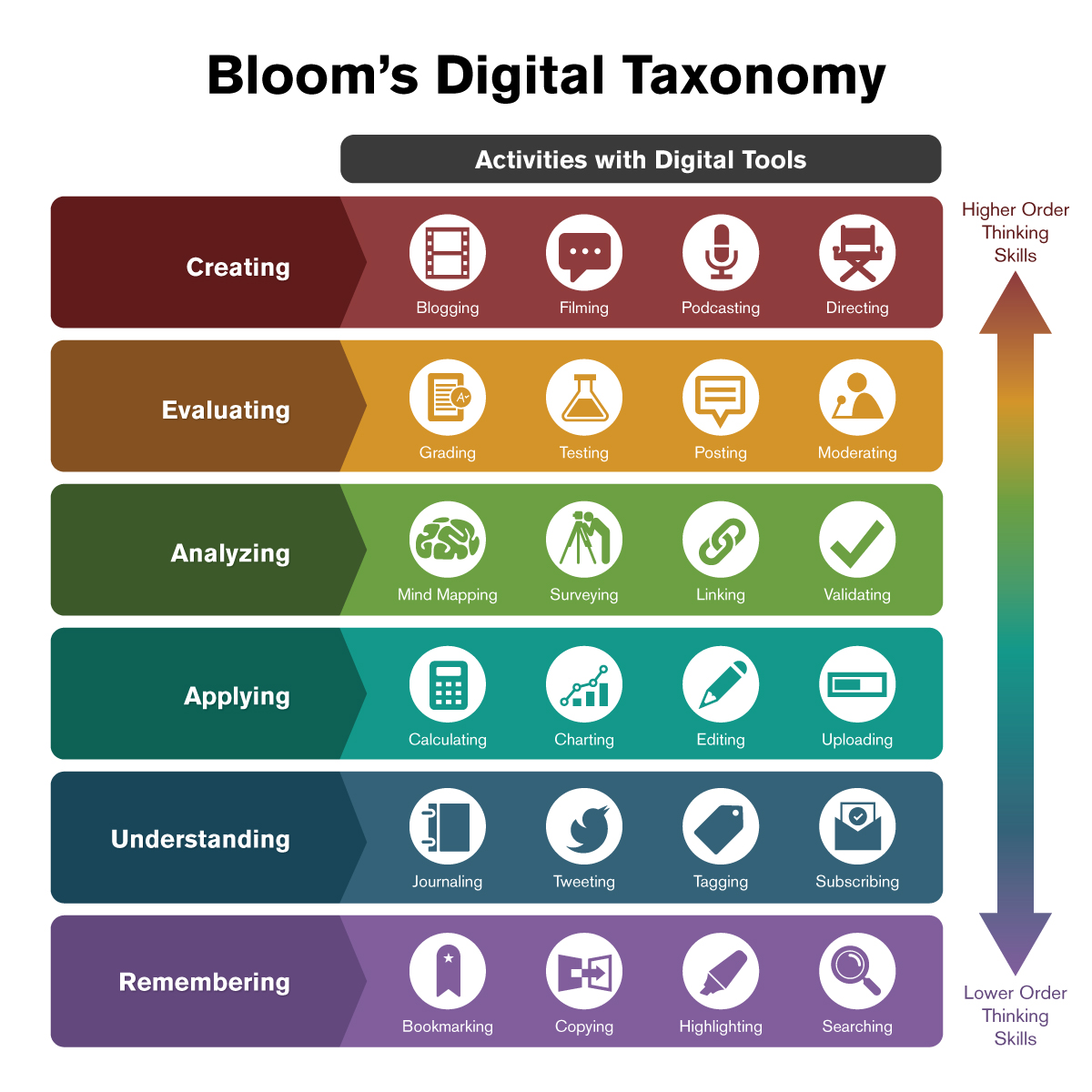Are you prepared to integrate digital tools into your student employee training?
Multiple research studies, including NASPA’s Employing Student Success project, have identified student employment as a high-impact practice. And well-crafted virtual training opportunities can help keep student employees’ professional development on track.
Here are eight activity ideas that combine the NACE career readiness competencies with digital tools, allowing supervisors to facilitate intentional virtual experiences.
8 Ideas
1. Critical Thinking/Problem Solving
Design thinking is a problem-solving approach that pairs critical thinking with a human-centered thought process. Students can apply the five phases of design thinking to problems that they’ll likely encounter in the workplace.
Here are some design-thinking activities that you can facilitate using a video conference platform and an online whiteboard platform (like Miro, Mural, or Lucidchart).
- UN 2030 Goals: Split students up into groups of three to six people and ask each to choose a UN 2030 Goal to research. Give them an hour or so to use the principles of design thinking to imagine ideas for reaching this goal. Finally, have each group give a short presentation on what their UN 2030 Goal is about and how to work towards it on the local, national, and international level.
- Maker Challenges: Have students complete the tasks set forward by the videos by this Maker Challenges playlist. There are a lot of fun design challenges, including inventing a new sport, designing the ultimate tiny house, and creating an eco-friendly kitchen.
- DIY Challenge: Explain a real problem that your office has and challenge students to use IBM’s Design Thinking Toolkit and the Human-Centered Design Kit to come up with a solution.
2. Oral/Written Communications
Students can demonstrate their written communication skills and impress potential employers with a standout LinkedIn summary.
A LinkedIn summary is like a written elevator pitch; students can use their profile to show some personality and make the reader want to learn more about them. In fact, LinkedIn’s research suggests that profiles with a summary are more likely to be viewed.
You can schedule time during your employee training to help students workshop their LinkedIn summaries. There is no magical formula for a great Linkedin summary; each will look differently depending on what industry the student is planning to go into.
Check with your career services office to inquire if they already offer LinkedIn workshops. If they do, you can collaborate with them during training.
As either a follow-up program or a stand-alone, students can review each others’ LinkedIn summaries and give feedback. This can be done synchronously through a video conference platform via screen sharing or asynchronously via discussion boards.
Before writing or revising their summaries, have your students review some of these resources:
- How to Write the Perfect LinkedIn Summary
- 3 Stunningly Good LinkedIn Profile Summaries
- 5 Template That’ll Make Writing the Perfect LinkedIn Summary a Total Breeze
- Headline & Summary Worksheet
3. Teamwork/Collaboration
The ability of each team member to manage conflict within the group is a major indicator of the team’s overall success.
There are five generally recognized conflict management styles:
- Accommodating: Put the other party’s needs before one’s own.
- Avoiding: Reduce conflict by ignoring it, removing the conflicted parties, or evading it in some manner.
- Compromising: Find the middle ground by asking both parties to concede some aspects of their desires so that a solution can be agreed upon.
- Competing: One party stands firm in what they think is the correct handling of a situation, and does not back down until they get their way.
- Collaboration: Each party’s needs and wants are considered, and a win-win solution is found so that everyone leaves satisfied.
Choosing the right style for a given situation depends on how quickly the disagreement needs to be resolved and how important the outcome is. Collaboration is ideal, but may not be the best approach if important deadlines are missed because it took a while to come to an agreement.
Have students take a conflict management style quiz, such as the one designed by Dr. Reginald Adkins, to identify how they handle conflict. Afterward, debrief as a group, discussing how each conflict management style might play out in different situations in their workplace.
4. Digital Technology
It seems that Gen Z students should be masters of all things technology; after all, they’re nicknamed “digital natives.”
However, most students use technology as a consumer device; they’re not used to using it as a tool for solving workplace problems. Jennifer Sparrow, the Associate Vice President of Teaching and Learning with Technology at Pennsylvania State University, illustrates why this is an important distinction for educators:
“How is digital fluency different from digital literacy? In learning a foreign language, a literate person can read, speak, and listen for understanding in the new language. A fluent person can create something in the language: a story, a poem, a play, or a conversation.”
To guide students towards digital fluency, consider using Bloom’s Digital Taxonomy. This modified version of the traditional taxonomy can help you prepare activities using digital tools. Here are some ideas:
- Improve your office’s manuals through visuals and infographics using tools like Canva or Piktochart. Read “10 Lame Documents that Would Be Better as Infographics” by Curtis Newbold for some inspiration.
- Take turns moderating a discussion board or a virtual meeting.
- Create how-to videos using screen-capture tools and/or a webcam to answer your office’s FAQs.

5. Leadership
When it comes to leadership, there is no shortage of reference materials available for you and your students to review. So, rather than having a facilitator focus on a single leadership topic, you can have students each pick a topic that they want to learn more about and research it. Then, set up a time for everyone to share what they learned via a short virtual presentation.
For synchronous presentations, students would share their screen on a video conference platform. For asynchronous presentations, students can use platforms like Prezi or VoiceThread and a discussion board to respond to presentations.
Here are some potential topics:
- Servant Leadership Model
- Situational Leadership Model
- Relational Leadership Model
- Social Change Model of Leadership Development
- Transformational Leadership
- Five Practices of Exemplary Leadership
- Maxwell’s 5 Levels of Leadership
- Maxwell’s 21 Irrefutable Laws of Leadership
Check out these eight additional virtual leadership activities for some more ideas.
6. Professionalism/Work Ethic
Employers often cite professionalism as a desirable trait in new employees, but what is it?
“The skill, good judgment, and polite behavior that is expected from a person who is trained to do a job well” — profressionalism as defined by Learner’s Dictionary
Notice that this definition doesn’t mention having to “be a professional.” It’s important for students to understand the difference between “being a professional” and “acting professionally”. During student employee training, discuss how students can demonstrate professionalism (acting professionally) even though they aren’t professionals yet.
Some benefits of professionalism that you can highlight for your students include the fact that professionalism:
- Develops trust with customers/co-workers
- Fosters a workplace culture of respect
- Encourages individual and group improvement
- Improves cooperation between co-workers
- Creates a more positive workplace atmosphere
- Enhances personal and employer reputation
Equally as important to this conversation is getting students to think critically about professionalism as a social construct. To help students think from this perspective, have them read and discuss articles like You Call It Professionalism; I Call It Oppression in a Three-Piece Suit and Maintaining Professionalism In The Age of Black Death Is….A Lot.
Here are some questions to guide your discussion:
- In what ways is “professionalism” a social construct?
- What do you think of the concept of “professionalism” after reading the article(s)?
- How could “professionalism” be used to create safe, comfortable, and productive spaces at work, instead of oppressive spaces?
Student affairs professionals who supervise students must model the sort of justice-oriented professionalism that they expect from their employees.
7. Career Management
Before students write their cover letters, elevator pitches, or mission and vision statements, they need to know what their personal brand is. A personal brand encompasses the unique combination of skills, experiences, and personality traits that you want other people (especially potential employers) to associate with you.
Having a personal brand can help students distinguish themselves from other graduates with similar qualifications.
There are several steps that you can take to help students define their personal brand.
- First, watch The Importance of Personal Branding video by Brian Tracy with your students.
- Have students identify their three most important values from a values list.
- Using their values as a guide, have students contemplate what attributes they want to be associated with. (Which areas of work do they excel at? What motivates them? What characteristics have others complimented them on?)
- Have students explain their personal brand to the group. Supervisors and students’ coworkers can serve as sounding boards for this exercise. If there is a discrepancy between how the group perceives the student and the brand that they are trying to project, help them figure out what actions the student needs to take to change that perception.
Here are some examples of how a student might express their personal brand:
- “I am a problem-solver who sees every project through from idea conception to assessment data collection.”
- “I focus on transforming business processes in a way that reduces their impact on the environment.”
- “I combine psychology and sociology to be the best advocate that I can for struggling families.”
Now, students will be ready to infuse their personal brands into how they present themselves to employers.
8. Global/Intercultural Fluency
As the world becomes more and more interconnected, it’s essential for students to constantly learn about global cultures. Effective teamwork in the workplace depends on team members understanding and respecting each other’s cultural differences.
One methodology for teaching intercultural fluency is to give students a framework for understanding differences in cultures, such as Hofstede’s Cultural Dimensions. The six dimensions in Geert Hofstede’s model are:
- Power Distance: The degree to which people are comfortable influencing upward
- Uncertainty Avoidance: How comfortable people are changing the way that they work or live
- Individualism vs. Collectivism: How personal needs and goals are prioritized verse the goals of the group
- Masculinity vs. Femininity: Masculine societies have more rules for men and women, but this is less so in feminine cultures.
- Long-Term vs. Short-Term Orientation: Planning for the future versus focusing on the present
- Indulgence vs. Restraint: Degree to which societies can exercise control over their impulses and desires
Students can use this model to discuss where different countries fall on the spectrum of each dimension, as compared to their own. You could even team up with a faculty member who is knowledgeable about intercultural communication to run a workshop. To really hone in on how culture and language shape our worldview, watch Lera Boroditsky’s TED Talk “How language shapes the way we think.”
You can feel confident in the rigor of your training curriculum with these engaging virtual activities. Don’t let the inability to meet in person prevent you from bringing professional development opportunities to your students.

What additional ideas do you have? Connect with us on Twitter @themoderncampus and @JustinTerlsiner.





